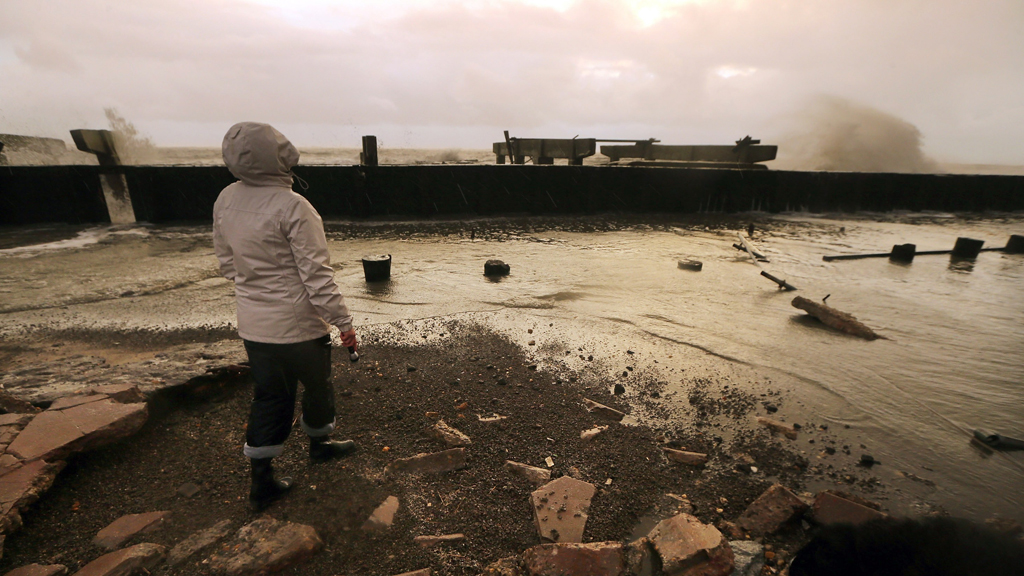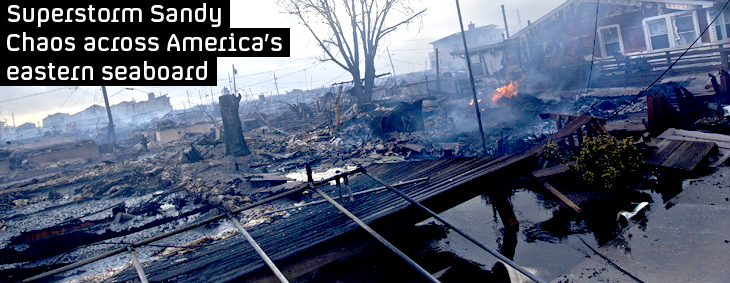Superstorm Sandy leaves east coast reeling
At least 33 people are killed and around 8 million are left without power after Superstorm Sandy wreaks havoc on America’s east coast, causing President Obama to declare a “major disaster”.

Millions along the east coast of America woke up to scenes of destruction and no power, as Superstorm Sandy moved slowly inland after battering the coast line overnight.
The New Jersey coastline was hit by winds of up to 90 miles per hour and an unprecedented 13-foot surge of seawater was hurled at New York City, flooding its tunnels, subway stations and the electrical system that powers Wall Street. Much of the Atlantic seaboard suffered from massive floods.
The storm was continuing to plough westward over south central Pennsylvania, still packing near hurricane-force winds as strong as 65 miles per hour, said the National Weather Service.
At least 33 people were killed across the east coast – many by falling trees – in New Jersey, New York, West Virginia, Pennsylvania and Connecticut, adding to the 58 who already died because of the hurricane in the Caribbean.
Superstorm Sandy: the latest
– Barack Obama declares a “major disaster” in New York City, New Jersey and Long Island.
– Around 50 to 60 million people across the east coast are expected to be affected by the superstorm.
– Over 200 patients were evacuated from New York University’s Tisch Hospital after the power went out and a backup generator failed.
– The New York Stock Exchange will stay shut on Tuesday – the first time since 1888 that weather has prevented it from opening for two days.
– A nuclear power plant called Oyster Creek, in New Jersey, was put on high alert due to rising water.
– Sandy lost its hurricane status late on Monday night, and is now a tropical storm.
President Barack Obama declared a “major disaster” in both New York and New Jersey, and an estimated 8 million people along the US east coast were hit by power outages, including two million in New York.
The storm has interrupted the US presidential campaign a week before election day on 8 November, and both President Obama and Mitt Romney were forced to cancel campaign events.
For the first time since 1888, the New York Stock Exchange will be closed for two consecutive days due to weather. One disaster forecasting company predicted that economic losses could ultimately reach as much as $20bn.
Google map below plots videos of the storm submitted by US residents and curated by Storyful.
New York a ‘ghost town’
“The worst of the weather has come and the city certainly is feeling the impacts,” said Michael Bloomberg, New York City mayor. “We have seen record surge levels, we’re seeing an extraordinary amount of water throughout lower Manhattan. There are trees down throughout the city.” He urged people to stay away from exposed power lines.
Large sections of New York City were without power, and transportation in the metropolitan area was at a standstill. Residents watched whole areas of the city disappear into darkness as power was cut and the World Trade Center site was a glowing ghost near the tip of lower Manhattan.
Amateur video shot on a mobile phone from across the East River in Brooklyn showed what appeared to be an explosion at a ConEd power station in lower Manhattan.
Almost everyone did heed the warnings of officials, stocked up on supplies and hunkered down. My neighbourhood, at least what I could see of it from my window while working from home, was a ghost town. Kevin Dolak, New York resident
“Hitting at high tide, the strongest surge and the strongest winds all hit at the worst possible time,” said Jeffrey Tongue, a meteorologist for the weather service in Brookhaven, New York.
Water poured into the subway system and tunnels under the city, raising concerns that the world’s financial capital could be out of action for days. Schools are expected to be closed for four to five days in New York City, and the city’s subway system is also suspended. New Yorkers posted pictures on twitter of flooded stations and a water-filled Ground Zero.
“In my experience people were at first a bit sceptical, particularly after Hurricane Irene more or less missed the city last year,” Kevin Dolak, Brooklyn resident, told Channel 4 News. “In the end though, almost everyone did heed the warnings of officials, stocked up on supplies and hunkered down. My neighbourhood, at least what I could see of it from my window while working from home, was a ghost town.”
Transport suspended
The Metropolitan Transportation Authority (MTA) said it could take anywhere from 14 hours to four days to get the water out of the flooded subway tunnels, the MTA said
“The New York city subway system is 108 years old, but it has never faced a disaster as devastating as what we experienced last night,” said Joseph Lhota, MTA chairman. “Hurricane Sandy wreaked havoc on our entire transportation system, in every borough and county of the region. It has brought down trees, ripped out power and inundated tunnels, rail yards and bus depots.”
New York City’s three major airports remained closed. Overall, more than 13,500 flights had been cancelled for Monday and Tuesday, almost all related to the storm, according to the flight-tracking service FlightAware.
In pictures: Superstorm Sandy hits the United States
Tropical storm
“It’s total devastation down there, there are boats in the street five blocks from the ocean,” said evacuee Peter Sandomeno, one of the owners of the Broadway Court Motel in Point Pleasant Beach, New Jersey. “That’s the worst storm I’ve ever seen, and I’ve been there for 11 years.”
Just before the centre of the storm reached land, it was stripped of hurricane status and was reclassified as a tropical storm, but the distinction was purely technical, based on its shape and internal temperature. It still packed hurricane-force winds, and forecasters were careful to say it remained every bit as dangerous to the 50 to 60 million people in its path.
In the Breezy Point areas of the New York City borough of Queens, 50 homes were burned to the ground in the early hours of Tuesday morning.
Election campaigning cancelled
Superstorm Sandy also devastated both the preidential candidates’ election campaign strategies, just one week before election day. Obama cancelled campaign events Monday and Tuesday as he stayed in the White House to manage the vast emergency that hit the heavily populated region between Washington and Boston and began to stretch toward Chicago and the Midwest.
Mitt Romney and running mate Paul Ryan also announced they were cancelling events.
